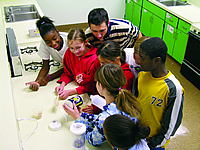|
Issue Contents :: Around Tappan Square :: [ 1 2 3 4 ]
Holistic Living
by Katie Hubbard ’05
“Those of us committed to sustainability have a very important role to play over the next four years,” said environmentalist Belden Paulson ’50, creator of a Wisconsin ecological village called the High Wind Association.
Paulson received the Alumni Association’s
Distinguished Achievement Award in November, and during his visit
addressed an Oberlin audience about his philosophy and work in sustainability
issues.
With his lecture falling just days after the November 2 election, he positioned his comments in the political moment, outlining his commitment to the environment and his hope of inspiring students to “seek change.”
With a degree in economics, Paulson left Oberlin in 1950 wanting to help “rebuild post-war Europe.” After biking across the Swiss Alps with some classmates, he ventured into Italy, where he volunteered with the World Council of Churches and later developed the Homeless European Land Program to re-settle displaced Naples families to rural Sardinia.
In between, he earned a PhD in political science at the University of Chicago and joined the faculty of the University of Wisconsin, Milwaukee, where he taught for more than three decades. There, he combined his training in economics and political science with his real-world work in rural Brazil and in conducting Vietnam-era peace dialogues. Some considered him an early pioneer of interdisciplinary studies.
Paulson pulled all these threads together in the 1970s to consider issues of sustainability. With an interest in alternative communities, he and his wife, Lisa Hills Paulson ’50—who had wanted to go beyond the classroom and “do something practical”—converted their 45-acre farm in Plymouth, Wis., into the High Winds Community, which since 1980 has grown into a 148-acre community whose 425 families practice sustainable agriculture and organic farming.
“It’s a no-brainer,” he said during his Oberlin lecture. “We must continue to raise the question of how to break out of our paradigm box.”
Guest Direction: Sir Simon Rattle, famed music director of the Berlin Philharmonic, led the Oberlin Chamber Orchestra in a performance of Mahler’s Symphony
No. 4 in December. “Virtually everything about this performance was stamped by magnificence,” wrote the Cleveland Plain
Dealer. Rattle’s son is a student in the Conservatory.
Hands-On Science
Is a Hands-Down Hit
by Betty Gabrielli
What do you get when you mix Jell-O, gumdrops, jelly-beans,
and licorice sticks?
Why, a 3-D model of a cell, of course. That is, if you are a sixth-grader in Marcia Stewart’s Life Science class at Langston Middle School.
“Hands-on projects are always big hits with sixth graders,” says Stewart. Especially when they can be eaten, which the students did the next day.
Oberlin Assistant Professor of Biology Marta Laskowski and senior Sam Merrett worked with Stewart last summer to develop new ways to strengthen the science curriculum at Langston. The result was a series of hands-on lab activities that make use of everyday materials, such as Jell-O and candy. Their work was supported by the Oberlin Partnership, an alliance formed in 2000 by the College and the City of Oberlin to collaborate on solutions to problems facing the city, including improving the schools.
Merrett (right, at top), an environmental
studies major, was considered an invaluable aid in the project, sharing
methods he developed last year while teaching high school students
about energy issues.
 “That experience had a huge impact on my work for Langston,” he says. “It was challenging and fun to modify the lessons and techniques for a different subject and for younger students. It’s exciting that the College and the schools can work together to expand the learning experiences for students at both institutions.” “That experience had a huge impact on my work for Langston,” he says. “It was challenging and fun to modify the lessons and techniques for a different subject and for younger students. It’s exciting that the College and the schools can work together to expand the learning experiences for students at both institutions.”
Not all of the experiments were edible. In the unit on energy, Stewart wanted to reinforce the concept that plants convert light energy into another form of energy that drives cellular reactions. “We had the kids measure the amount of light absorbed by a solar panel to determine how it relates to the charge on a battery,” she says. “Before, the kids were limited to reading about
the processes in their textbooks, so they really enjoy the labs. They’re engaged and excited about this new approach, as are their parents.”
The Laskowski-Stewart collaboration got its start last spring at a Langston open house. Stewart expressed her plans to beef up the life science units, and Laskowski agreed to help.
“Marta is a wellspring of ideas, inspiration, and knowledge,” Stewart says. “I plan to bounce ideas off her regarding the other sixth grade science disciplines. I have labs and activities lined up for each of them.”
Dennison Smith, president of the Oberlin Board of Education and professor of neuroscience at the College, is also enthusiastic about the College’s involvement in the schools. The science pilot project was funded by Oberlin’s Office of the President.
“When the public schools and the College work
together, they both profit from the experience,” Smith says. “Because
the school system is small, money is limited. The schools must educate
a diverse student body, so it is sometimes difficult for them to
do things that are truly distinctive. However, with input from College
faculty members, interesting initiatives like this have emerged.”
Next Page >>
|





